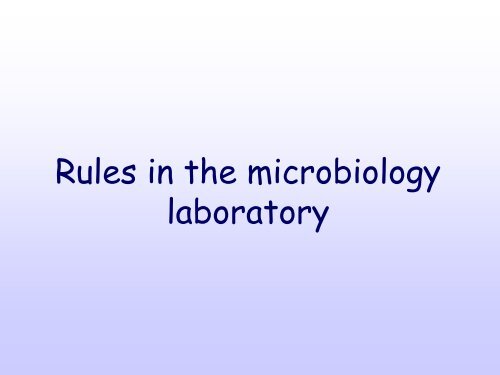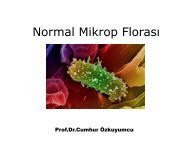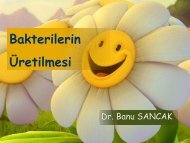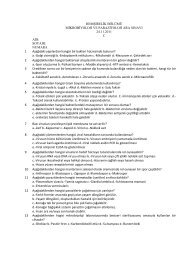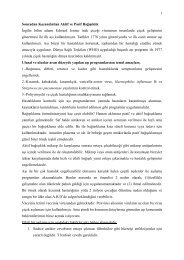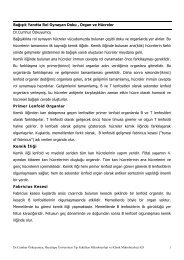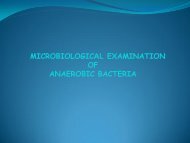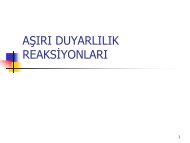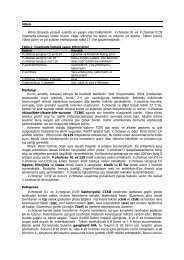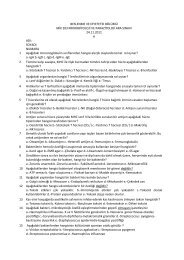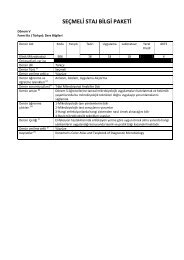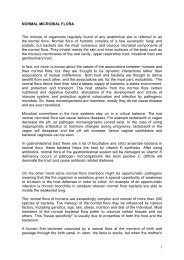PowerPoint Sunusu
PowerPoint Sunusu
PowerPoint Sunusu
- No tags were found...
You also want an ePaper? Increase the reach of your titles
YUMPU automatically turns print PDFs into web optimized ePapers that Google loves.
Rules in the microbiologylaboratory
Rules• Loops and the other metal stuff shouldbe sterilized before and after use.• Liquid media should be kept in tubeholders.• If the working area is contaminated itshould be cleaned with alcohol.• Benches, microscopes and otherlabware used should be cleaned up.• Hands should be washed with soapbefore leaving the laboratory.
Rules• It is recommended to write and drawa report of the lab studies at the endof the laboratory hour.
Inoculation and Evaluation ofClinical samplesFirst Day
ClinicalsampleWrongmediainoculationLaboratoryerrorsFalseresultRepeatof testIrrationalantibioticuse
ContainersFalcon tubeSputum,urine...Sterile containerurine,sputum...Non-sterilecontainersstool...
Transport MediumReady for useUsed
AnaerobicTransport Mediumtablet liquid cotton cotton liquid cotton swab
Microbiological Examination• Macroscopic examination• Microscopic examination• Culture– Selection of media– Inoculation– Incubation– Evaluation (with direct smear)• Macroscopic examination of the colonies• Microscopic examination of the colonies• Manual tests• Automated or semi-automated identification systems• Antibiotic susceptibility testing• Report
Macroscopic examination• Urine– colour– turbidity• Stool– blood, mucus– watery stool• Pus– blood• Throat– .• Sputum– blood, mucus, purulent material
Microscopic examination• Preparation of direct smear from thesample– Wet mount• Examination without staining• Staining with iodine• Staining with indian ink• …– Fixed• Gram staining• Methylene blue staining• Giemsa staining• …
Culture– Selection of medium– Inoculation– Incubation– Evaluation ( with a direct smear ifexists)• Macroscopic examination of the colonies• Microscopic examination of the colonies• Manual tests• Automated or semi-automated identificationsystems• Antibiotic susceptibility testing
Selection of mediaAppropriate media are selected according tothe clinical sample.• Nutrient medium• Enrichment media: Blood,chocolate agar• Selective media: MacConkey, EMB agar• Differential media:– Blood agar: Hemolysis– MacConkey agar,EMB agar: Lactose utilization– SS agar: Lactose utilization, H 2 S production
Selection of the media accordingto the sample• Urine: Blood agar, EMB agar• Throat: Blood agar• Sputum , BAL, DTA: Blood agar, EMB agar, chocolate agar• Stool: EMB agar, SS agar• Blood: Blood culture bottle• CSF: Blood agar, EMB agar, chocolate agar• Sterile body fluids: Blood agar, EMB agar• Pus, wound: Blood agar, EMB agar• Tissue, surgery material: Blood/EMB agar, sampleinoculation into the liquid media• Vagina: Blood agar, EMB agar, chocolate agar, antiboticcontaining Columbia agar• Urethral swab: sheep blood/EMB agar, chocolate agar
Selection of the media accordingto the culture demand• Anaerobe culture: Schaedler, phenyl ethanol, BBE agar,thioglycolate broth, also aerobic culture with blood, EMBand chocolate agars.• Tuberculosis culture: Loewenstein-Jensen medium,Middlebrook medium• Diphtheria : Loeffler medium, blood agar with tellurite• Pertussis: Bordet-Gengou medium• Cholera: TCBS agar, alkaline pepton water• EHEC: Sorbitol containing MacConkey agar• Yersinia: CIN agar• Helicobacter• Campylobacter• Vancomycin resistant enterococcus• ………….
Enrichment media• Some extra nutritional materials canbe added such as blood, egg, serum.• Most of the microorganisms grow onthese media– blood agar– chocolate agar
Selective media• These media are selective because they inhibitsome bacteria and permit the growth of others.- EMB or MacConkey agar– Antibiotic containing chocolate agar (Thayer-Martin agar)
Differential Media• Because of the indicators they have,similar bacteria form different colonies.– Blood agar– EMB or MacConkey agar
• Liquid specimen– Quadrant streak:• Stool• Sputum– Quantitative• Urine• BAL, DTA• Catheter• Swab– Quadrant streak:• Pus• Throat• TissueInoculation
• Purecoloniesfrom allthebacteriaculturedmay beobtained.Quadrant streak platetechnique
Quantitative inoculation• A certain amount ofliquid specimen isinoculated.– 10 µL for urine (aloopful)• Afterwards growthof colonies arecounted to obtainnumber of bacteriaper mL.
Urine• Medium: Blood agar, MacConkey agar• Inoculation:– Quantitative inoculation to blood agar : 10μL (a loopful)– Inoculation with Quadrant streak plate technique toMacConkey agar : 10μL (a loopful)• Incubation: Normal atmosphere, 36-/+2ºC,overnight
Stool• Medium: MacConkey agar, SS agar• Inoculation: Quadrant streak plate technique• Incubation: Normal atmosphere, 36-/+2ºC,overnight
Pus, wound, tissue, drainage andsurgical materials• Medium: Blood agar, MacConkey agar• Inoculation: Quadrant streak plate technique• Incubation: Normal atmosphere, 36-/+2ºC,overnight
Throat• Medium: Blood agar• Inoculation: Quadrant streak plate technique,by stabbing the agar.• Incubation: Normal atmosphere, 36-/+2ºC,overnight
Sputum (will be shown on day 2)• Medium: Blood agar, MacConkeyagar, chocolate agar• Preparate: two• Inoculation: Quadrant streak platetechnique• Incubation: candle jar
Incubation• Appropriate temperature– 35-37°C• Appropriate atmosphere– Aerobe (incubator)– %5 CO 2 (candle jar or incubator with %5 CO 2 )– Anaerobe– Microaerophilic• Appropriate time– 16-18 hours (one night)– 24 hours– 48 hours– 7 days– …
First day• Front bench– Containers• Sterile urinecontainer• Non-sterilecontainer• Sterile falcon tube• Transport medium• Each bench– Clinical samples• Urine: Blood and MacConkeyagar• Stool: MacConkey and SS agar• Pus: Blood and MacConkey agar• Throat: Blood agar– Media to be inoculated• Blood agar• MacConkey agar• SS agar
Inoculation of clinicalsamples and evaluation ofculturesSecond day
Evaluation of the cultures• Growth of the causative agent ofinfection• Identification of the microorganism• -/+ antibiotic susceptibility testing
Evaluation of direct smear
Evaluation of direct smear
Evaluation of direct smear
Evaluation of direct smear
Evaluation of Culture Plate• What is the sample? Is the sample sterile?Has it been taken from a body site whichhas normal flora?• Any growth?• Colony count? (for quantitative inoculation)• How many types of bacteria?• If we are seeking a certain pathogen, do anycolonies have characteristics of it?
Evaluation of Culture• Macroscopic examination of colonies• Microscopic examination of colonies• Manual tests• Automated or semi-automatedidentification systems• Antibiotic susceptibility testing
Macroscopic Examination ofColonies• Colony morphology• Differentialcharacteristics ofthe media:– Blood agar:Hemolysis– MacConkey agar:Lactose utilization– SS agar: H2Sproduction
Hemolysis• Blood agar– Alpha-hemolysis– Beta-hemolysis– Gamma-hemolysis
Lactose utilization• Mac Conkey agar– Lactose positive– Lactose negative
H2S production• SS agar:– H2S positive– H2S negative
Microscobic examination of the• Gram stainingcolonies
Manual tests• Catalase• Coagulase• Oxidase• CAMP• Growth at 6.5% salt medium• Growth at Bile-esculin medium• Optochin susceptibility• Bacitracin susceptibility• Biochemical tests:– TSI(triple sugar iron) medium– IMVIC– Urease test– …
Automated or Semiautomatedidentificationsystems
Antibotic Susceptibility Tests
Second Day• Front bench– Ready made slidesfrom sputum samples– Sputum culture plates• Each bench– Evaluation ofculture plates– Gram staining
Gram staining•Crystal violet (1 min)•Wash with water•Lugol (1 min)•Wash with water•Alcohol (30 sec)•Wash with water•Fuchsin (30 sec)•Wash with water


